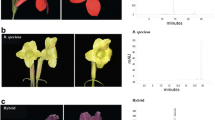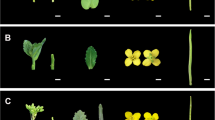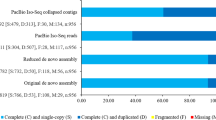Abstract
Key message
The genome-wide allele-specific expression in F1 hybrids from the cross of tropical and temperate lotus unveils how cis-regulatory divergences affect genes in key pathways related to ecotypic divergence.
Abstract
Genetic variation, particularly cis-regulatory variation, plays a crucial role in phenotypic variation and adaptive evolution in plants. Temperate and tropical lotus, the two ecotypes of Nelumbo nucifera, show distinction in the degree of rhizome enlargement, which is associated with winter dormancy. To understand the roles of genome-wide cis-regulatory divergences on adaptive evolution of temperate and tropical lotus (Nelumbo nucifera), here we performed allele-specific expression (ASE) analyses on the tissues including flowers, leaves and rhizome from F1 hybrids of tropical and temperate lotus. For all investigated tissues in F1s, about 36% of genes showed ASE and about 3% of genes showed strong consistent ASE. Most of ASEs were biased towards the tropical parent in all surveyed samples, indicating that the tropical genome might be dominant over the temperate genome in gene expression of tissues from their F1 hybrids. We found that promoter sequences with similar allelic expression are more conserved than genes with significant or conditional ASE, suggesting the cis-regulatory sequence divergence underlie the allelic expression bias. We further uncovered biased genes being related to phenotypic differentiation between two lotus ecotypes, especially metabolic and phytohormone-related pathways in the rhizome. Overall, our study provides a global landscape of cis-regulatory variations between two lotus ecotypes and highlights their roles in rhizome growth variation for the climatic adaptation.





Similar content being viewed by others
Data availability
All data analyzed during this study are included in this article or its supplementary information files. Sequencing raw data used in this study have been GeneBank under NCBI BioProject: PRJNA557796 and PRJNA552661.
References
Abelenda JA, Navarro C, Prat S (2011) From the model to the crop: genes controlling tuber formation in potato. Curr Opin Biotechnol 22:287–292. https://doi.org/10.1016/j.copbio.2010.11.013
Aksenova NP, Konstantinova TN, Golyanovskaya SA, Sergeeva LI, Romanov GA (2012) Hormonal regulation of tuber formation in potato plants. Russ J Plant Physiol 59:451–466. https://doi.org/10.1134/S1021443712040024
AmitavBhattacharya (2019) Chapter 5—high-temperature stress and metabolism of secondary metabolites in plants. p 391–484. https://doi.org/10.1016/B978-0-12-817562-0.00005-7
Benjamini Y, Hochberg Y (1995) Controlling the false discovery rate: a practical and powerful approach to multiple testing. J R Stat Soc 57:289–300. https://doi.org/10.1111/j.2517-6161.1995.tb02031.x
Bird KA, VanBuren R, Puzey JR, Edger PP (2018) The causes and consequences of subgenome dominance in hybrids and recent polyploids. New Phytol 220:87–93. https://doi.org/10.1111/nph.15256
Brouard JS, Schenkel F, Marete A, Bissonnette N (2019) The GATK joint genotyping workflow is appropriate for calling variants in RNA-seq experiments. J Anim Sci Biotechnol 10:44. https://doi.org/10.1186/s40104-019-0359-0
Cao D, Damaris RN, Zhang Y, Liu M, Li M, Yang P (2019) Proteomic analysis showing the signaling pathways involved in the rhizome enlargement process in Nelumbo nucifera. BMC Genomics 20:766. https://doi.org/10.1186/s12864-019-6151-x
Carlson CH, Choi Y, Chan AP, Serapiglia MJ, Town CD, Smart LB (2017) Dominance and sexual dimorphism pervade the Salix purpurea L. Transcriptome. Genome Biol Evol 9:2377–2394. https://doi.org/10.1093/gbe/evx174
Charnock SJ, Davies GJ (1999) Structure of the nucleotide-diphospho-sugar transferase, SpsA from Bacillus subtilis, in native and nucleotide-complexed forms. Biochemistry 38:6380–6385. https://doi.org/10.1021/bi990270y
Chen C, Chen H, Zhang Y, Thomas HR, Frank MH, He Y, Xia R (2020) TBtools: an integrative toolkit developed for interactive analyses of big biological data. Mol Plant 13:1194–1202. https://doi.org/10.1016/j.molp.2020.06.009
Combes MC, Hueber Y, Dereeper A, Rialle S, Herrera JC, Lashermes P (2015) Regulatory divergence between parental alleles determines gene expression patterns in hybrids. Genome Biol Evol 7:1110–1121. https://doi.org/10.1093/gbe/evv057
Deng J, Chen S, Yin X, Wang K, Liu Y, Li S, Yang P (2013) Systematic qualitative and quantitative assessment of anthocyanins, flavones and flavonols in the petals of 108 lotus (Nelumbo nucifera) cultivars. Food Chem 139:307–312. https://doi.org/10.1016/j.foodchem.2013.02.010
Diaz-Valenzuela E, Sawers RH, Cibrian-Jaramillo A (2020) Cis- and trans-regulatory variations in the domestication of the chili pepper fruit. Mol Biol Evol 37:1593–1603. https://doi.org/10.1093/molbev/msaa027
Edger PP et al (2017) Subgenome dominance in an interspecific hybrid, synthetic allopolyploid, and a 140-year-old naturally established neo-allopolyploid monkeyflower. Plant Cell 29:2150–2167. https://doi.org/10.1105/tpc.17.00010
Edger PP et al (2019) Origin and evolution of the octoploid strawberry genome. Nat Genet 51:541–547. https://doi.org/10.1038/s41588-019-0356-4
Ereful NC et al (2016) Analysis of allelic imbalance in rice hybrids under water stress and association of asymmetrically expressed genes with drought-response QTLs. Rice (N Y) 9:50. https://doi.org/10.1186/s12284-016-0123-4
Gaur U, Li K, Mei S, Liu G (2013) Research progress in allele-specific expression and its regulatory mechanisms. J Appl Genet 54:271–283. https://doi.org/10.1007/s13353-013-0148-y
Grebner W, Stingl NE, Oenel A, Mueller MJ, Berger S (2013) Lipoxygenase6-dependent oxylipin synthesis in roots is required for abiotic and biotic stress resistance of Arabidopsis. Plant Physiol 161:2159–2170. https://doi.org/10.1104/pp.113.214544
Guo M, Rupe MA, Zinselmeier C, Habben J, Bowen BA, Smith OS (2004) Allelic variation of gene expression in maize hybrids. Plant Cell 16:1707–1716. https://doi.org/10.1105/tpc.022087
Guo M, Yang S, Rupe M, Hu B, Bickel DR, Arthur L, Smith O (2008) Genome-wide allele-specific expression analysis using Massively Parallel Signature Sequencing (MPSS) reveals cis- and trans-effects on gene expression in maize hybrid meristem tissue. Plant Mol Biol 66:551–563. https://doi.org/10.1007/s11103-008-9290-z
He F et al (2012) Widespread interspecific divergence in cis-regulation of transposable elements in the Arabidopsis genus. Mol Biol Evol 29:1081–1091. https://doi.org/10.1093/molbev/msr281
Kyozuka J (2007) Control of shoot and root meristem function by cytokinin. Curr Opin Plant Biol 10:442–446. https://doi.org/10.1016/j.pbi.2007.08.010
Laity JH, Lee BM, Wright PE (2001) Zinc finger proteins: new insights into structural and functional diversity. Curr Opin Struct Biol 11:39–46. https://doi.org/10.1016/S0959-440X(00)00167-6
Leaden L, Busi MV, Gomez-Casati DF (2014) The mitochondrial proteins AtHscB and AtIsu1 involved in Fe-S cluster assembly interact with the Hsp70-type chaperon AtHscA2 and modulate its catalytic activity. Mitochondrion 19(Pt B):375–381. https://doi.org/10.1016/j.mito.2014.11.002
Lee JH et al (2008) Characterization of Arabidopsis and rice DWD proteins and their roles as substrate receptors for CUL4-RING E3 ubiquitin ligases. Plant Cell 20:152–167. https://doi.org/10.1105/tpc.107.055418
Li F, Asami T, Wu X, Tsang EW, Cutler AJ (2007) A putative hydroxysteroid dehydrogenase involved in regulating plant growth and development. Plant Physiol 145:87–97. https://doi.org/10.1104/pp.107.100560
Li T et al (2020) Brassinosteroids regulate root meristem development by mediating BIN2-UPB1 module in Arabidopsis. PLoS Genet 16:e1008883. https://doi.org/10.1371/journal.pgen.1008883
Libault M, Thibivilliers S, Bilgin DD, Radwan O, Benitez M, Clough SJ, Stacey G (2008) Identification of four soybean reference genes for gene expression normalization. Plant Genome 1:44–54. https://doi.org/10.3835/plantgenome2008.02.0091
Liu Z et al (2008) Modulation of eIF5A1 expression alters xylem abundance in Arabidopsis thaliana. J Exp Bot 59:939–950. https://doi.org/10.1093/jxb/ern017
Liu Q, Guo Y, Li J, Long J, Zhang B, Shyr Y (2012) Steps to ensure accuracy in genotype and SNP calling from Illumina sequencing data. BMC Genomics 13(Suppl 8):S8. https://doi.org/10.1186/1471-2164-13-S8-S8
Martin Castro AM (2004) Claisen rearrangement over the past nine decades. Chem Rev 104:2939–3002. https://doi.org/10.1021/cr020703u
Min H et al (2016) Identification of drought tolerant mechanisms in maize seedlings based on transcriptome analysis of recombination inbred lines. Front Plant Sci 7:1080. https://doi.org/10.3389/fpls.2016.01080
Mishra BS, Singh M, Aggrawal P, Laxmi A (2009) Glucose and auxin signaling interaction in controlling Arabidopsis thaliana seedlings root growth and development. PLoS ONE 4:e4502. https://doi.org/10.1371/journal.pone.0004502
Mitra SK, Gantt JA, Ruby JF, Clouse SD, Goshe MB (2007) Membrane proteomic analysis of Arabidopsis thaliana using alternative solubilization techniques. J Proteome Res 6:1933–1950. https://doi.org/10.1021/pr060525b
Nielsen R, Paul JS, Albrechtsen A, Song YS (2011) Genotype and SNP calling from next-generation sequencing data. Nat Rev Genet 12:443–451. https://doi.org/10.1038/nrg2986
Pastinen T (2010) Genome-wide allele-specific analysis: insights into regulatory variation. Nat Rev Genet 11:533–538. https://doi.org/10.1038/nrg2815
Pirinen M et al (2015) Assessing allele-specific expression across multiple tissues from RNA-seq read data. Bioinformatics 31:2497–2504. https://doi.org/10.1093/bioinformatics/btv074
Ravi V, Chakrabarti S, Makeshkumar T, Saravanan R (2014) Molecular regulation of storage root formation and development in sweet potato. Hortic Rev 42:157–208. https://doi.org/10.1002/9781118916827.ch03
Robinson MD, McCarthy DJ, Smyth GK (2010) edgeR: a Bioconductor package for differential expression analysis of digital gene expression data. Bioinformatics 26:139–140. https://doi.org/10.1093/bioinformatics/btp616
Shao L et al (2019) Patterns of genome-wide allele-specific expression in hybrid rice and the implications on the genetic basis of heterosis. Proc Natl Acad Sci USA 116:5653–5658. https://doi.org/10.1073/pnas.1820513116
Shekhar S et al (2016) Ectopic expression of amaranth seed storage albumin modulates photoassimilate transport and nutrient acquisition in sweetpotato. Sci Rep 6:25384. https://doi.org/10.1038/srep25384
Shi X, Ng DW, Zhang C, Comai L, Ye W, Chen ZJ (2012) Cis- and trans-regulatory divergence between progenitor species determines gene-expression novelty in Arabidopsis allopolyploids. Nat Commun 3:950. https://doi.org/10.1038/ncomms1954
Shi T et al (2020) Distinct expression and methylation patterns for genes with different fates following a single whole-genome duplication in flowering plants. Mol Biol Evol 37:2394–2413. https://doi.org/10.1093/molbev/msaa105
Song G et al (2013) Global RNA sequencing reveals that genotype-dependent allele-specific expression contributes to differential expression in rice F1 hybrids. BMC Plant Biol 13:221. https://doi.org/10.1186/1471-2229-13-221
Springer NM, Stupar RM (2007) Allele-specific expression patterns reveal biases and embryo-specific parent-of-origin effects in hybrid maize. Plant Cell 19:2391–2402. https://doi.org/10.1105/tpc.107.052258
Springob K, Nakajima J, Yamazaki M, Saito K (2003) Recent advances in the biosynthesis and accumulation of anthocyanins. Nat Prod Rep 20:288–303. https://doi.org/10.1039/b109542k
Steige KA, Reimegard J, Koenig D, Scofield DG, Slotte T (2015) Cis-regulatory changes associated with a recent mating system shift and floral adaptation in capsella. Mol Biol Evol 32:2501–2514. https://doi.org/10.1093/molbev/msv169
Steige KA, Laenen B, Reimegard J, Scofield DG, Slotte T (2017) Genomic analysis reveals major determinants of cis-regulatory variation in Capsella grandiflora. Proc Natl Acad Sci USA 114:1087–1092. https://doi.org/10.1073/pnas.1612561114
Stern DL, Orgogozo V (2008) The loci of evolution: how predictable is genetic evolution? Evolution 62:2155–2177. https://doi.org/10.1111/j.1558-5646.2008.00450.x
Sun SS, Gugger PF, Wang QF, Chen JM (2016) Identification of a R2R3-MYB gene regulating anthocyanin biosynthesis and relationships between its variation and flower color difference in lotus (Nelumbo Adans.). PeerJ 4:e2369. https://doi.org/10.7717/peerj.2369
Valuchova S, Fulnecek J, Prokop Z, Stolt-Bergner P, Janouskova E, Hofr C, Riha K (2017) Protection of Arabidopsis blunt-ended telomeres is mediated by a physical association with the Ku heterodimer. Plant Cell 29:1533–1545. https://doi.org/10.1105/tpc.17.00064
Van der Auwera GA et al (2013) From FastQ data to high confidence variant calls: the Genome Analysis Toolkit best practices pipeline. Curr Protoc Bioinform. https://doi.org/10.1002/0471250953.bi1110s43
Wang JY, Guo ML, Lin WX, Wu JZ (2004) DNA preparation method for lotus (Nelumbo nucifera Gaertn.), containg hight polysaccharide. Fujian Sci Technol Rice Wheat 22:8–9
Wei G et al (2009) A transcriptomic analysis of superhybrid rice LYP9 and its parents. Proc Natl Acad Sci USA 106:7695–7701. https://doi.org/10.1073/pnas.0902340106
Wittkopp PJ (2011) Using pyrosequencing to measure allele-specific mRNA abundance and infer the effects of cis- and trans-regulatory differences. Methods Mol Biol 772:297–317. https://doi.org/10.1007/978-1-61779-228-1_18
Wittkopp PJ, Kalay G (2011) Cis-regulatory elements: molecular mechanisms and evolutionary processes underlying divergence. Nat Rev Genet 13:59–69. https://doi.org/10.1038/nrg3095
Yan Q, Xia X, Sun Z, Fang Y (2017) Depletion of Arabidopsis SC35 and SC35-like serine/arginine-rich proteins affects the transcription and splicing of a subset of genes. PLoS Genet 13:e1006663. https://doi.org/10.1371/journal.pgen.1006663
Yang M, Zhu L, Pan C, Xu L, Liu Y, Ke W, Yang P (2015) Transcriptomic analysis of the regulation of rhizome formation in temperate and tropical lotus (Nelumbo nucifera). Sci Rep 5:13059. https://doi.org/10.1038/srep13059
Zhang Y, Nyong AT, Shi T, Yang P (2019) The complexity of alternative splicing and landscape of tissue-specific expression in lotus (Nelumbo nucifera) unveiled by Illumina- and single-molecule real-time-based RNA-sequencing. DNA Res 26:301–311. https://doi.org/10.1093/dnares/dsz010
Zhu HH, Yang JX, Xiao CH, Mao TY, Zhang J, Zhang HY (2019) Differences in flavonoid pathway metabolites and transcripts affect yellow petal colouration in the aquatic plant Nelumbo nucifera. BMC Plant Biol 19:277. https://doi.org/10.1186/s12870-019-1886-8
Acknowledgements
We thank Professor Jia Li from Lanzhou University, Mr. Razgar Seyed Rahmani and Professor Kathleen Marchal from Gent University for discussion.
Funding
This work was supported by grants from the National Natural Science Foundation of China (Nos. 31700197, 31570220 and 31870208), Youth Innovation Promotion Association of Chinese Academy of Sciences (No. 2019335), the Strategic Priority Research Program CAS (No. XDB31000000), Bureau of Landscaping and Forestry of Wuhan Municipality (No. WHGF2019A10), Hubei Provincial Natural Science Foundation of China (No. 2019CFB275) and Hubei Chenguang Talented Youth Development Foundation. The funding bodies played no role in the design of the study and collection, analysis, and interpretation of data and in writing the manuscript.
Author information
Authors and Affiliations
Contributions
TS and JC conceived and designed the project. HL and PY collected samples for whole-genome resequencing and RNA sequencing. PY discussed the manuscript. ZG performed the experiment and analysis. ZG wrote the original draft. TS and JC reviewed and edited the manuscript.
Corresponding authors
Ethics declarations
Conflict of interest
The authors declare no competing financial interests.
Additional information
Publisher's Note
Springer Nature remains neutral with regard to jurisdictional claims in published maps and institutional affiliations.
Supplementary Information
Below is the link to the electronic supplementary material.
Rights and permissions
About this article
Cite this article
Gao, Z., Li, H., Yang, X. et al. Biased allelic expression in tissues of F1 hybrids between tropical and temperate lotus (Nelumbo nuicfera). Plant Mol Biol 106, 207–220 (2021). https://doi.org/10.1007/s11103-021-01138-8
Received:
Accepted:
Published:
Issue Date:
DOI: https://doi.org/10.1007/s11103-021-01138-8




